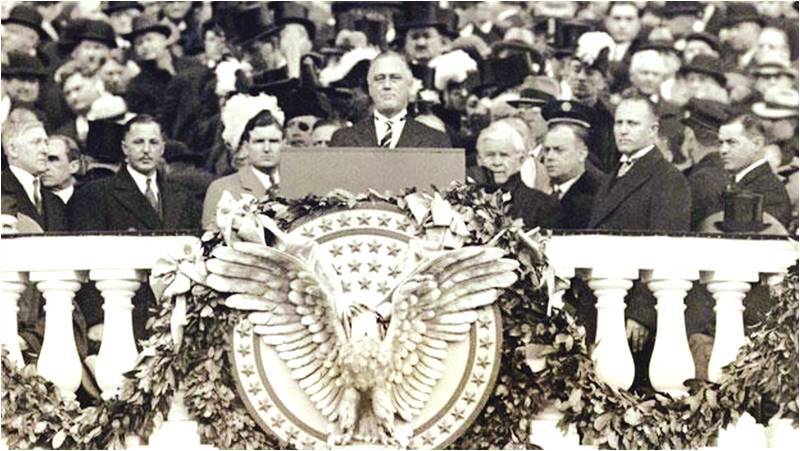
This photograph was captured on March 4, 1933, at the inauguration ceremony of the newly elected president of the United States, Franklin D. Roosevelt.
Roosevelt was elected at the height of the Great Depression. In his famous inaugural address, delivered outside the east wing of the U.S. Capitol, Roosevelt outlined his “New Deal”– an expansion of the federal government as an instrument of employment opportunity and welfare. He told Americans that “the only thing we have to fear is fear itself.” Although it was a rainy day in Washington, and gusts of rain blew over Roosevelt as he spoke, he delivered a speech that radiated optimism and competence, and a broad majority of Americans united behind their new president and his radical economic proposals to lead the nation out of the Great Depression.
Aided by a Democratic Congress, Roosevelt took prompt, decisive action, and most of his New Deal proposals, such as the Agricultural Adjustment Act, National Industrial Recovery Act, and creation of the Public Works Administration and Tennessee Valley Authority, were approved within his first 100 days in office. Although criticised by many in the business community, Roosevelt’s progressive legislation improved America’s economic climate, and in 1936 he easily won reelection.
During his second term, he became increasingly concerned with German and Japanese aggression and so began a long campaign to awaken America from its isolationist slumber. In 1940, with World War II raging in Europe and the Pacific, Roosevelt agreed to run for an unprecedented third term. Reelected by Americans who valued his strong leadership, he proved a highly effective commander in chief after the December 1941 U.S. entrance into the war. Under Roosevelt’s guidance, America became, in his own words, the “great arsenal of democracy” and succeeded in shifting the balance of power in World War II firmly in the Allies’ favour. In 1944, with the war not yet won, he was re-elected to a fourth term.
Three months after his inauguration, while resting at his retreat at Warm Springs, Georgia, Roosevelt died of a massive cerebral hemorrhage at the age of 63. Following a solemn parade of his coffin through the streets of the nation’s capital, his body was buried in a family plot in Hyde Park. Millions of Americans mourned the death of the man who led the United States through two of the greatest crises of the 20th century: the Great Depression and World War II. Roosevelt’s unparalleled 13 years as president led to the passing of the 22nd Amendment to the U.S. Constitution, which limited future presidents to a maximum of two consecutive elected terms in office.
Roosevelt was elected at the height of the Great Depression. In his famous inaugural address, delivered outside the east wing of the U.S. Capitol, Roosevelt outlined his “New Deal”– an expansion of the federal government as an instrument of employment opportunity and welfare. He told Americans that “the only thing we have to fear is fear itself.” Although it was a rainy day in Washington, and gusts of rain blew over Roosevelt as he spoke, he delivered a speech that radiated optimism and competence, and a broad majority of Americans united behind their new president and his radical economic proposals to lead the nation out of the Great Depression.
Aided by a Democratic Congress, Roosevelt took prompt, decisive action, and most of his New Deal proposals, such as the Agricultural Adjustment Act, National Industrial Recovery Act, and creation of the Public Works Administration and Tennessee Valley Authority, were approved within his first 100 days in office. Although criticised by many in the business community, Roosevelt’s progressive legislation improved America’s economic climate, and in 1936 he easily won reelection.
During his second term, he became increasingly concerned with German and Japanese aggression and so began a long campaign to awaken America from its isolationist slumber. In 1940, with World War II raging in Europe and the Pacific, Roosevelt agreed to run for an unprecedented third term. Reelected by Americans who valued his strong leadership, he proved a highly effective commander in chief after the December 1941 U.S. entrance into the war. Under Roosevelt’s guidance, America became, in his own words, the “great arsenal of democracy” and succeeded in shifting the balance of power in World War II firmly in the Allies’ favour. In 1944, with the war not yet won, he was re-elected to a fourth term.
Three months after his inauguration, while resting at his retreat at Warm Springs, Georgia, Roosevelt died of a massive cerebral hemorrhage at the age of 63. Following a solemn parade of his coffin through the streets of the nation’s capital, his body was buried in a family plot in Hyde Park. Millions of Americans mourned the death of the man who led the United States through two of the greatest crises of the 20th century: the Great Depression and World War II. Roosevelt’s unparalleled 13 years as president led to the passing of the 22nd Amendment to the U.S. Constitution, which limited future presidents to a maximum of two consecutive elected terms in office.

